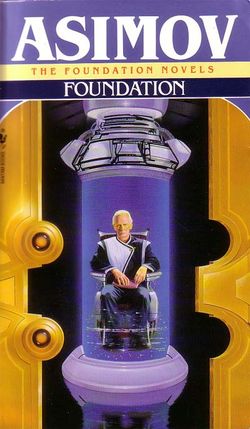Asimov's Writing Involving Robots |
Isaac Asimov wrote in both fiction and nonfiction. He began his career with fictional short stories and novels, and continued in this vein until a few years after receiving his Ph.D. During this time, he coined three new words relating to his science fiction stories: positronic—a fictional technology supposedly involving the particle with the opposite charge of an electron; psychohistory—the analysis and interpretation of historical events with the aid of psychological theory (“psycho-history”); robotics—the study and application of robot technology; and social science fiction—in the 1940s, the move from space opera to thinking about the human condition (“Isaac Asimov” Overview, Wikipedia).
Most of Asimov’s robot stories have a similar plotline: robot is created, robot seems to disobey three laws, robot is chased and captured by humans, and misunderstanding is cleared up. Despite the narrowness of this idea, Asimov created dozens of unique stories that examined different aspects or problems of the Three Laws. He preferred to write stories based on narration and dialogue with little action. Generally, the stories had between two and five major characters with a few minor characters. His stories were not written or published in chronological order but were instead written in the order he thought of them and finished them (much like C. S. Lewis’s Chronicles of Narnia). Acting on the advice of John Campbell, Asimov opened his stories “as late in the plot as possible” (“Isaac Asimov” Criticisms, Wikipedia). Almost all of his robot stories are written in this style. For many authors, this technique would not be successful. For Asimov, however, it helped give birth to a new style of science fiction writing
Social Oppression In contrast to the currents of paternalism found in much of Asimov’s work, the theme of social oppression also appears in several stories. Asimov wrote many of his stories at a troubled timed in history—the period before, during, and after the World Wars. By writing about oppression in stories, Asimov could express his ideas without being labeled unpatriotic or called a heretic. Most of the time, the victims of social oppression in his stories are humans who have either gotten themselves into trouble or have inadvertently gotten in the way of some greater issue in the universe. Typically the humans can find no way out, and the robots have to rescue the humans from their predicament, ironically combining paternalism with oppression. Though many times victims of oppression in Asimov’s stories are human, sometimes the robots are treated badly, as in The Caves of Steel, where “the people of Earth resent the wealthier ‘Spacers’ and in turn treat robots (associated with the Spacers) in ways reminiscent of how whites treated blacks” (“Isaac Asimov” Literary Themes, Wikipedia). |

